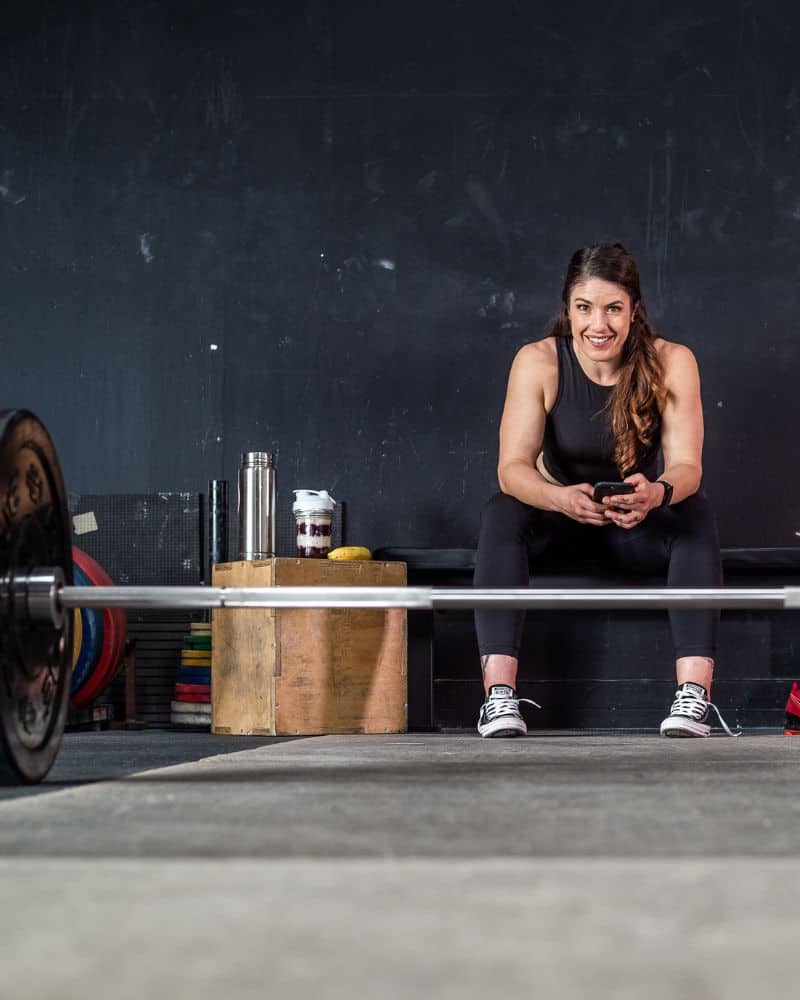Are you lifting heavy enough? It’s common for women to wonder if they’re lifting heavy enough to maximize strength gains.
It makes sense. You’re already juggling a lot, and when you carve out time to lift, you want that effort to pay off. You might also wonder if you’re doing the right exercises, using the best rep and set ranges, or choosing weights that truly challenge you for a return on your investment. And then there’s the common worry—what if I get bulky? (More on that below.)
Before diving in further, it’s important to mention the concept of progressive overload. Put simply, progressive overload means slowly, steadily changing different variables in your strength training program over time. Your body recovers from the new challenge, and positive improvements (gains) are made. If, however, the reps, sets, and weight lifted never change, improvements taper off, and a plateau is reached.
Another thing to remember is that lifting “heavy” is relative to each person. Said another way, a weight that’s light to you might be super hard to someone else. As you train consistently, weights that once felt intimidating start to feel manageable. That’s how you know you’re making progress.
When considering this question of lifting heavy “enough”, it’s important to reflect on your own goals, challenges, and progress along the way. There’s so much women stand to gain from strength training, from greater muscle mass and better insulin sensitivity; to better mental health and quality of life; and so much more.
This article delves into common concerns about lifting heavy.
What Does “Lifting Heavy” Really Mean for Women?
“Lifting heavy”, in a practical sense, means picking a weight for the set you’re doing that makes the set challenging.
A more useful term, however, might be “high effort” lifting. Since what’s heavy is different for everyone and also varies based on how many reps you’re doing, focus on form and fatigue level as indicators of effort.
When people hear “lifting heavy,” they often picture a powerlifter grinding out a one-rep max deadlift. And yes, that is heavy lifting—it’s the most weight that person can move for a single rep. But that’s just one context. If that same lifter set up to do a set of eight deadlifts, they’d use significantly less weight than their one-rep max. Why? Because lifting something eight times in a row demands a different kind of effort. The weight may be lighter, but the set can still feel intense.
When people say “lifting heavy” they commonly mean this a shorthand way for training for strength development, how well you can produce maximum force against an external load like a barbell. Generally, this is defined as lower repetition sets, 6 reps or less.
Compare that to what’s often described as “lifting lighter.” In everyday gym speak, lifting “lighter” often refers to more moderate hypertrophy rep ranges (ex: 8-15) or higher rep muscular endurance ranges (ex: 15+). The common goal of “looking toned” requires building muscle mass (or adding muscle while also losing body fat so the muscle shape is more visible). Muscle building is not only for bodybuilders!
More recent research such as this 2021 paper by Schoenfeld et al (1) is less settled on some aspects of the traditional rep range / continuum model. They note that muscle building appears to occur across a wide range of rep ranges but that moderate rep schemes (i.e. 6-12) may be more practical to achieve from a time and practicality standpoint. Again, there is likely a much wider range for muscle building than was once thought. The authors note that there could be sex differences among women that may influence adaptations across the rep ranges, but more research is needed to explore this.
The Most Common Myth: Lifting Heavy Makes Women Bulky
The most common myth is that lifting heavy makes women bulky. Let’s address this.
Women have, on average, 10% or less of the testosterone that men do—though this can very depending on many factors. Testosterone plays an important role as an anabolic hormone, meaning it helps build muscle, among tissues. However, testosterone isn’t the only hormone that has a role in building muscle, and mechanical tension applied to muscle is very important for muscle growth.
A client shared this concern about looking bulky with me. When I asked what that looked like to her, she sent me a photo of a professional bodybuilder. Then, I asked her to send me a photo of the type of physique she would find “not bulky.” What she gave me was an athletic looking woman with modest, visible muscle shape.
Bodybuilders put intense effort to building their physique through targeted training (often for several years), diet manipulation, and sometimes, performance enhancing substances. In reality, it takes a significant amount of effort to build even a small amount of muscle mass. Nobody builds a huge amount of muscle mass casually or quickly. Put another way, women can build muscle through a well designed strength training program implemented over time, but an extreme level of muscle mass gain isn’t a realistic outcome.
Though it’s beyond the scope of this article, it must be also mentioned that the internalization of unrealistic body standards, past history of dieting or under-eating, disordered eating, etc can skew one’s idea of realistic expectations for body shape and size.
Muscle and metabolism play a role in female strength training.
By adding more muscle to your body, you increase the amount of energy your muscles use at rest, when you move, and during structured exercise. Research suggests (2) that a pound of muscle burns about 6 calories. As a simple concept, adding muscle improves basal metabolic rate. It also increases the energy needed to move your body around in daily life and during exercise itself. When all of that is factored in, the figure may be a bit closer to 9 or 10 calories burned per pound of added muscle.
However, it’s important to note that some of the claims made about building muscle and the benefits for metabolism are often exaggerated. Yes, strength training is beneficial for women, it doesn’t mean passively burning an extra 1000 calories a day by building a few pounds of muscle. Using the estimate above, if you build five pounds of muscle, you may be burning an extra 50-ish calories per day.
Even though the extra calories used by building muscle tends to not be dramatic, it’s absolutely worth doing. Lifting weights to build strength is beneficial for mood, sleep, energy levels, and getting around more easily in daily life.
Building muscle is one half of the “improve body composition” equation, often along with losing body fat. So if you want to improve body composition or the appearance of a toned body, your training should include building muscle through high effort strength training; cardiovascular exercise; and creating a reasonable and sustainable calorie deficit via nutrition changes. It should be noted that though the number on the scale may not change much, body composition may still shift and appear different. Focusing solely on weight doesn’t always provide the whole picture.
Though women have different hormonal profiles to men, they are absolutely capable of building strength and muscle mass through resistance training. What’s most important is lifting challenging enough weights no matter the rep scheme and being consistent over time.
Mistakes Women Make When Choosing Weights
There are some common mistakes women make when choosing weights to lift.
Of course, these apply to anyone who lifts weights, but many women face challenges such as: they’re often less likely to have experience with strength training as part of school sports teams; may feel more intimidated in male dominated gym settings; and may have internalized the “thin ideal” of body and beauty standards that idealizes a slight and non-muscular build for women.
According to the 2020 National Health Interview Survey, “Of total adults, 31.0% met the guidelines for muscle-strengthening activity, with or without meeting the aerobic activity guidelines.” The report also states, “In 2020, 28.3% of men and 20.4% of women met the guidelines for both aerobic and muscle-strengthening activities.”
Furthermore, as women get older, they are meeting physical activity guidelines less often: “The percentage of women who met the guidelines for both physical activities decreased with age, from 28.7% of those aged 18–34, to 22.7% of those aged 35–49, to 17.6% of those aged 50–64, and 10.8% of those aged 65 and over.”
Women may tend to:
- Stay in the “comfort zone” when it comes to familiar exercises, using the same rep and sets schemes for very long periods of time, or always using the same weights. This may be due to lack of guidance, feeling more intimidated by free weight areas of the gym, being “warned” repeatedly that strength training is dangerous, or not knowing how to progress a plan.
- Women are constantly told that “long and lean” muscle is desirable but “bulky muscle” is not. These messages often come from popular culture and from within the fitness industry itself. Women may continue sticking to “tiny pink dumbbells” even though they’re capable of lifting more. This leads to a lack of progress.
- When weights aren’t gradually increase over time, especially if reps and sets are held relatively constantly, there is less stimulus for adaptation. With proper recovery, progressive overload leads to muscle growth, strength gains, and greater resilience. In other words, if muscles are not challenged progressively over time, improvement will stall. There may be a period of maintaining the adaptations that were made. But eventually, if not challenged again, losses will outpace gains.
How to Know You’re Lifting Heavy Enough: Actionable Strategies
Here are some actionable strategies to know if you’re lifting heavy enough:
- Use the guideline that “last 2-3 reps of your set should feel challenging, with decent form.” If you can easily complete the set and keep going with no issues, you may need to add a little weight.
- Use the Rate of Perceived Exertion or Reps in Reserve scale to assess and adjust your lifting.
- Track your progress with a workout journal or app. Seeing your progress data is vital. This can help you spot possible plateaus before they start.
- If you’re ready to go up in weight, try small jumps up. General guidelines: Upper body muscles are smaller, so increases will generally be smaller, say 2.5 to 5 pounds. Lower body muscles are bigger and stronger, so those jumps up may be a bit larger, from 5 to 10 pounds. If you make an increase and you’re unable to complete the set or you feel your form really breaking down, it’s totally fine to stop and go back down in weight.
- Record video of your lifts for valuable visual feedback. Often, you’ll know you’re in that sweet spot with lifting “heavy” or high effort enough when the weight starts moving a bit slower in the last couple reps. Alternatively, get feedback from your coach or workout partner. Ask them to observe whether the weight slowed down at all toward the end of the set or if your form started to really break down.
- Set realistic goals and assess them often. Focus most on the process of working toward your goals since the exact timeline to hit a particular milestone number in strength training is difficult to predict.
- How much have I improved my strength in [this exercise] since I started?
- On a scale of 1-10, how consistent have I been with my lifting program? If lower than 7, what barriers are in my way and what is my plan to get around them?
- What positive changes have I noticed in my day to day life / chosen sport / workplace, etc as a result of lifting weights?
Signs You’re Progressing and Getting Stronger
There are many signs you’re progressing and getting stronger, ranging from physical to mental health improvements as well lifestyle indicators.
First and foremost, strength training is beneficial for physical health and function. Lifting weights can improve physical strength, power, endurance, and sports performance.
You may notice weights that once challenged you are easier over time; you’re can do more reps of an exercise; you are doing more advanced variations of an exercise; or that your movement quality is improving. For example, maybe you’re squatting a little deeper than before or you can step up onto a box more easily. You may notice you can move more quickly than before or your muscles take much longer to get tired.
Health-wise, exercise can improve insulin sensitivity and benefit bone density, among other factors. The bone density aspect is relevant for women who are at higher risk for low bone density (osteopenia or osteoporosis). A 2011 meta-analysis by Howe et al of over 4300 postmenopausal women suggested that exercise resulted in a small but statistically significant benefit to bone density (3).
A more recent 2018 paper by Hong and Kim summarized the effect of resistance training on muscle and bone and concluded that strength training may indeed be important in maintaining musculoskeletal health (4). Furthermore, a 2018 review by Benedetti et al concluded, “Progressive resistance training for the lower limbs is the most effective type of exercise intervention on bone mineral density (BMD) for the neck of femur.” (5)
When it comes to mental health, there’s interesting research into the benefit of strength training for mental health, including anxiety and mild depression. A 2017 meta-analysis by Gordon et al of 922 total participants concluded that resistance training had a statistically significant positive effect on anxiety symptoms. (6)
In 2018, a meta-analysis by Gordon et al examined study data from 1877 participants on the effect of resistance training on mild depression. This meta-analysis concluded that, “Resistance exercise training significantly reduced depressive symptoms among adults regardless of health status, total prescribed volume of RET, or significant improvements in strength.” (7)
Beyond the gym, and perhaps most notably, strength training gains show up in daily activities. You may notice more energy and better posture. Daily activities such as chores around the house or yard, carrying groceries, moving heavy objects, and climbing stairs become easier.
One 60 year old client shared that she could finally pick up and carry a 40 pound bag of cat litter on her own. Another client, a mom of two small children in her early 40s, noted that she carried them around much more easily while on vacation because she’s stronger now.
FAQs: Women and Lifting Heavy
Do I need to lift heavy to tone my muscles?
- If you want a toned muscle appearance, you need to build muscle. That can be accomplished by using various rep schemes across the lifting continuum. The most important thing is to lift with high effort, exposing your muscle to enough mechanical tension. This means choosing a weight that you could only lift 1-3 more times with decent form at the end of the set. Progress continually over time so you don’t plateau, but not so quickly that you increase the risk of injury.
How often should I increase my weights?
- How often you increase your weights will depend on how long you’ve been lifting, how many times a sessions you do a week, and more. A general guideline is once you can easily complete the reps and sets of an exercise at a certain weight without much challenge, it’s time to consider an increase. If you can easily complete a set with the weight you did last week and you could keep going and do more than a few reps, consider going up.
- Increase reps until you get to the top of the rep range prescribed by your program, then change the weight. For example, if it’s 3 sets of 8-12 reps, start with 8 reps at 20 pounds. The following week, shoot for 9-10 reps, and the week after that, 11-12 reps. Once you can do 12 reps with 20 pounds, increase the weight slightly.
- Beginners might increase the weight more frequently, as often as every 1-2 weeks. Intermediates might increase every 2-4 weeks. Advanced lifters could see a month or longer go by before they add weight. These are general timelines, and there are always exceptions.
Is it safe to lift heavy if I’m a beginner or older adult?
- No matter your level, you must get clearance from your medical doctor before you begin any exercise program, including lifting weights. An appropriately designed and progressed strength training program offers many benefits for adults of all ages.
- As a beginner or older adult, it’s generally advisable to start out by working with a fitness professional who can assess and guide you. You’ll likely start with simpler (though effective!) exercises, more moderate repetitions, and might use machines as you get used to resistance training with lighter to moderate efforts. As your experience level progresses and your form improves, you may start increasing the weight for higher effort sets, move to free weight exercises, or vary your rep schemes more.
- If you’re an older adult, it’s important to let your fitness professional know about any concerns you have—like balance issues, low bone density, or other health conditions—so they can adjust your training plan to help reduce risk.
- Many older adults lift heavier weights at lower reps once they’ve progressed to that point and gained experience.
Should I lift heavy if I have certain health conditions?
- You should always consult with your doctor or healthcare provider before beginning any lifting program. Certain exercises, techniques, or load may not be appropriate depending on your condition.
Final Thoughts: Embrace Your Strength and Keep Challenging Yourself
The journey of strength training is yours and yours alone. Keep track of your progress, and celebrate your wins. Remember that progress isn’t only determined by the weight you lift—it could be competing in a half marathon with stronger legs, climbing stairs more easily, getting your first pull-up, or finally doing all the outdoor activities on your family vacation.
Building strength through lifting weights is incredibly empowering, and the process is unique for every woman. Connect to what lights you up about it, how it helps you live into your values, or why lifting is moving you closer to the type of woman you’re committed to becoming.
If you’re ready to experience the power of strength training with the peace of mind of an expertly designed plan, try a free 7 day sample of Strong with Steph.
References
(1) Schoenfeld BJ, Grgic J, Van Every DW, Plotkin DL. Loading Recommendations for Muscle Strength, Hypertrophy, and Local Endurance: A Re-Examination of the Repetition Continuum. Sports (Basel). 2021 Feb 22;9(2):32. doi: 10.3390/sports9020032. PMID: 33671664; PMCID: PMC7927075.
(2) Wang Z, Ying Z, Bosy-Westphal A, Zhang J, Schautz B, Later W, Heymsfield SB, Müller MJ. Specific metabolic rates of major organs and tissues across adulthood: evaluation by mechanistic model of resting energy expenditure. Am J Clin Nutr. 2010 Dec;92(6):1369-77. doi: 10.3945/ajcn.2010.29885. Epub 2010 Oct 20. PMID: 20962155; PMCID: PMC2980962.
(3) Howe TE, Shea B, Dawson LJ, Downie F, Murray A, Ross C, Harbour RT, Caldwell LM, Creed G. Exercise for preventing and treating osteoporosis in postmenopausal women. Cochrane Database Syst Rev. 2011 Jul 6;(7):CD000333. doi: 10.1002/14651858.CD000333.pub2. PMID: 21735380.
(4) Hong AR, Kim SW. Effects of Resistance Exercise on Bone Health. Endocrinol Metab (Seoul). 2018 Dec;33(4):435-444. doi: 10.3803/EnM.2018.33.4.435. PMID: 30513557; PMCID: PMC6279907.
(5) Benedetti MG, Furlini G, Zati A, Letizia Mauro G. The Effectiveness of Physical Exercise on Bone Density in Osteoporotic Patients. Biomed Res Int. 2018 Dec 23;2018:4840531. doi: 10.1155/2018/4840531. PMID: 30671455; PMCID: PMC6323511.
(6) Gordon BR, McDowell CP, Lyons M, Herring MP. The Effects of Resistance Exercise Training on Anxiety: A Meta-Analysis and Meta-Regression Analysis of Randomized Controlled Trials. Sports Med. 2017 Dec;47(12):2521-2532. doi: 10.1007/s40279-017-0769-0. PMID: 28819746.
(7) Gordon BR, McDowell CP, Hallgren M, Meyer JD, Lyons M, Herring MP. Association of Efficacy of Resistance Exercise Training With Depressive Symptoms: Meta-analysis and Meta-regression Analysis of Randomized Clinical Trials. JAMA Psychiatry. 2018 Jun 1;75(6):566-576. doi: 10.1001/jamapsychiatry.2018.0572. PMID: 29800984; PMCID: PMC6137526.








